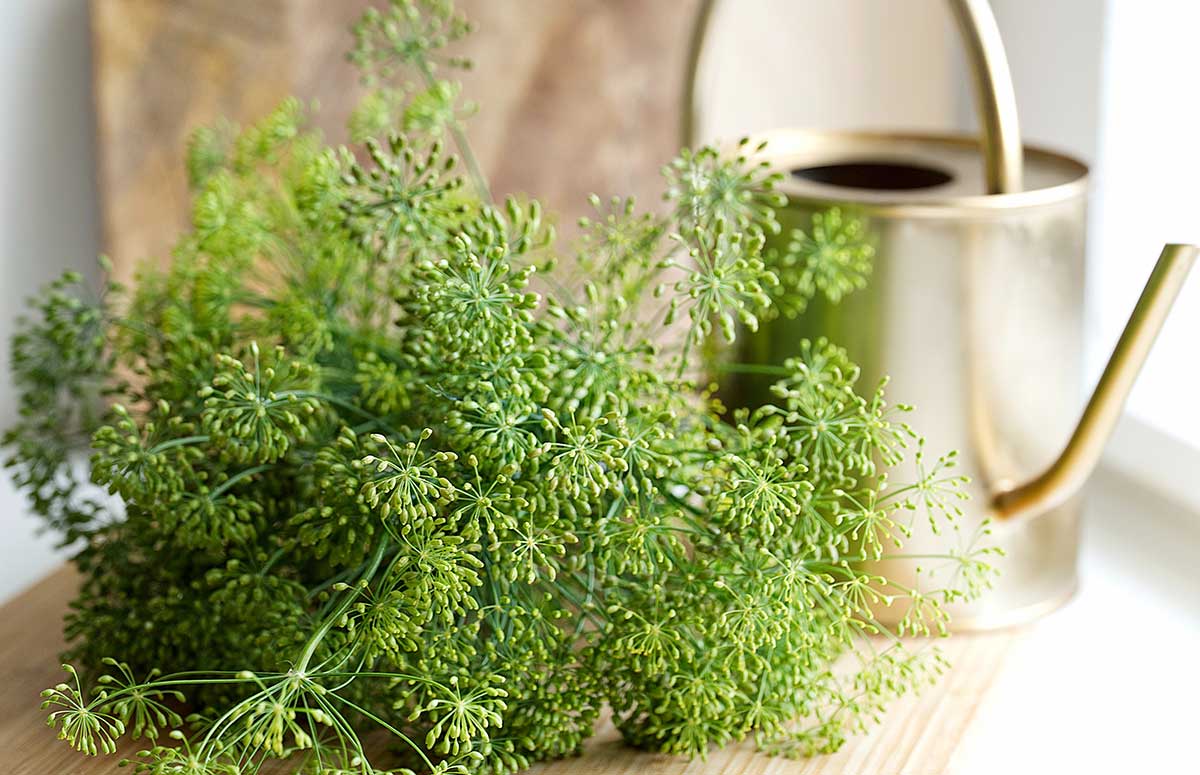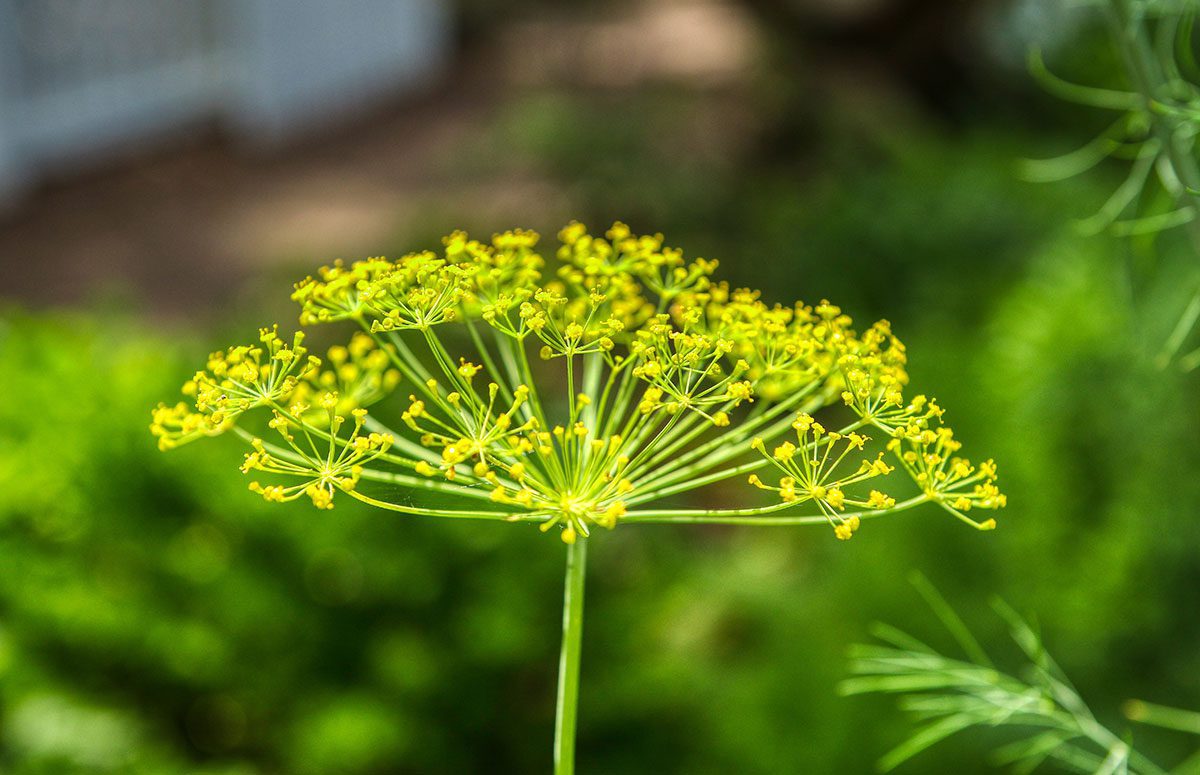The first reason for growing dill that pops into a gardener’s mind might be for their pickles. But its value is far greater than enhancing cucumbers. This easy-to-grow garden herb deserves equal billing for natural healing and the kitchen.
History
Technically known as Anethum graveolens, the common name of dill comes from the German language.
A native to southern Europe, the Mediterranean, and western Africa, the first known instance of dill having curative properties was 5,000 years ago in ancient Egypt. They used it for soothing ailments, as an aphrodisiac, and for protection from witches. To Greeks of old, dill represented wealth, while the Romans considered it to attract good fortune. Armies burned dill seed, applying it to soldiers’ wounds for faster healing.

While dill continued to be used for warding off witches into the 16th century, it was also known to calm the ‘wicked winds’ of the stomach. Dill seed followed large meals as a digestive, and all parts of the plant have been soothing stomach ailments, and moving gas for thousands of years. But that’s just the beginning of its curative and health benefits.
Health Benefits
Most of the medicinal properties of dill are due to its Monoterpene compounds, but also come from the vitamins, minerals, flavonoids, and amino acids the plant contains.
Rich in vitamins A and C, the herb offers trace amounts of calcium, iron, folate, and manganese. The monoterpenes and flavonoids include anethofuran, carvone, limonene, kaempferol, and vicenin. The herb has antidepressant, antimicrobial, and antioxidant properties.
Consuming dill or dill oil is good for your bones and boosts the immune system. It can ease muscle cramps and soothe aches while reducing inflammation. Dill also inhibits fungal infection. It calms hiccups, offers relief for infant colic and menstrual cramps, as well as increasing nursing mothers’ milk, and regulating menstrual cycles.
It’s said to repel bugs, treat depression, boost energy, lower cholesterol, and protect against free radicals. You can also use it to do away with bad breath, reduce your risk of cancer, cure respiratory illnesses, and it’s an aid to managing insulin levels for diabetics… among other things.
Obviously, growing dill puts a wealth of goodness at your fingertips.
Varieties Of Dill To Grow
Common Dill
A tall plant that is a bit rangy. Some would call it open and airy. It reaches around 3 feet tall. It’s not the best thing for container growing.
Bouquet Dill
The most widely grown variety. It reaches 30″ tall but has far better dill weed and seed head production than common dill. Best grown in the ground.
Elephant Dill
A much larger variety at 3-4 feet tall. Late-blooming, and not a container plant.
Mammoth Dill
Doesn’t appear to have any unique qualities. It grows 3 feet high.
Fernleaf Dill
Perfect for containers. It grows up to 18″ tall and is very late blooming. If you’re after more leaf than seed, it’s a good choice. Also known as Dwarf Fernleaf.
Compatto Dill
Gets only 12-18″ high at maturity. Great for containers. Rumored at having the best flavor.
Goldkrone Dill
A bunching variety that delivers lots of foliage. Slow to bloom.
Superdukat Dill
Super tall, reaching 4.5-5 feet at maturity. It grows uniformly and is later blooming than Bouquet.
Hera Dill
Another bunching variety that produces lots of leaves. Slow to flower. Matures at 18-24″ tall.
Tetra Dill
Super bushy and late to flower. Lots of dill weed. It gets 30-36″ high.
Hercules Dill
A very old slow to flower variety that grows 30-36″ tall.
With so many improved varieties to grow, you’ll probably want a more efficient crop than age-old common dill.
How To Grow Dill
Dill is a full sun annual plant that does well in hardiness zones 3-9. No matter what method you choose, this herb prefers 5.5-6.5 pH but will tolerate up to 7.5 pH. Growing dill is best started from seed rather than buying garden center plants, because dill doesn’t transplant well.
Grow Dill From Seed
The best approach to starting dill is sowing the seed directly into your garden soil, or the container it will mature in. If you must start it ahead of the weather, it would be wise to do so in a biodegradable pot, so the roots are undisturbed at planting time.

Sow your seeds 1/8 inch deep indoors, but 1/4 inch deep outside. Keep the soil or growth medium moist. If starting seed indoors, a humidity dome will help protect against media getting too dry for good germination.
Germination takes 7-21 days, and soil temperature should be 60-70º F. Check the seed packet for proper plant spacing for the variety you chose. Some dill grows wider than others.
To ensure that you’ve got a continual supply of fresh dill weed, you’ll want to start new plants in succession every 3 weeks. Slow to bolt (late blooming) types help but don’t provide a never-ending harvest.
Conventional Crop Notes
Dill isn’t a demanding plant to grow. Growing dill in average garden soil is fine, as is standard fertilizer or nutrients. A good quality potting mix is best for growing your dill in pots or containers. But don’t try a shallow container. That deep taproot needs some toe space for traveling. If your dill flops over later in the season – your container isn’t deep enough. I recommend a minimum pot depth of 10″. Even then you might need to stake tall varieties.
Once established, dill can deal with drought, thanks to its deep taproot. However, your harvest will be lessened in such stressful conditions. Lush foliage is always the result of consistent moisture, and that’s one of the key reasons for growing dill in the first place. At the same time, it needs good drainage and doesn’t do well when overwatered.
This is a low-maintenance plant, but too much overhead irrigation, excessively wet weather, and poor drainage can cause fungal problems like leaf spots and root diseases.
Growing Dill Indoors
For best vegetative efficiency, growing dill indoors requires at least 12 hours under lights a day. It will grow in a south-facing window but isn’t as productive as under grow lights. Got a sunny window? Use this windowsill method to grow your dill.
While very happy in the hydroponic garden, there are a couple of reasons why most people prefer growing dill in the backyard garden or containers. One is the size of the plant. Even if choosing to grow the shorter Compatto or Fernleaf varieties, it’s still a big plant that gets 12-18″ tall and 18-24″ wide. And, unlike other herbs, it doesn’t replenish the foliage once cut. Not very efficient use of your grow room space, especially when it’s small.
But, if you want to give it a try, start your seeds in rock wool. Move the young plants into the system when the first true leaf appears. Be sure to give it a place in the back, because it will quickly start shading the other plants in a grow room. Have new seedling(s) ready to replace the old plants once you’ve harvested the dill weed.
How To Harvest Dill
Enjoying garden fresh dill weed is possible once the plant is established until flowering begins. Your dill weed harvest is at peak potential 40-55 days after sowing seed. However, you can start snipping foliage once your plant has 4-5 leaf stems. Once you’ve cut the stems, they don’t replenish the supply.

You can stall flowering by pinching out bud stems, but the flavor of the leaves changes rapidly once the plant enters the blooming stage. The flowers are edible, but if you want seed, refrain from eating them. Mature seed heads take 85-105 days. While seed to the early harvest stage is the same for all varieties of dill, seed harvesting stage varies a bit.
Once the seed pods turn golden brown it’s time to harvest them. If left on the plant too long, they won’t be the best quality for eating. Here are some “best methods” for harvesting and processing seeds.
How To Store Dill
Once you’ve cut dill, you need to do something with it quickly. The foliage is quite delicate, and washing it after harvest destroys the volatile oils, and speeds deterioration. It’s best to give the plant a light shower and allow it to dry completely before cutting.
Whole stems can be stored in a jar of water to keep them fresh longer. However, to keep the flavor as intense as possible, create a humidity dome with a plastic bag. This also stalls wilting if the water in the jar doesn’t allow moisture to form inside the plastic cover.
You can store freshly cut dill weed in the refrigerator for a few days in a plastic bag. Do add a piece of paper toweling to absorb condensation.
You can also freeze dill to preserve the pungent fresh flavor. A coarse chop is best. Bigger pieces hold flavor better.
Finally, you can dry both dill weed and seed, and store them in air-tight jars.
Dill: Farm-To-Table
Wildly popular in Russia today, dill is also prominent in Scandinavian, Central European, and North African cuisine. You’ll also find it featured in recipes from Asian countries, Iran, and India. So, get adventurous, there’s no shortage of creative ways to add fresh dill to meals.
Dill pairs up nicely with meats, fish, vegetables, eggs, pasta, and dairy products. It’s most commonly found in recipes with a tangy or sour note, like salad dressings and meat rubs.
While you can use all parts of the plant, fresh or dried, the leaves, known as dill weed, are most commonly used in recipes. The more pungent seeds are more popular for pickling.
The best dill weed flavor comes from just harvested leaves. If you use dried dill weed, it will take a lot more to get the same taste that those garden fresh leaves impart. Quite the opposite of most culinary herbs.



One Response
Hi,
Thanks for sharing these amazing information about this plant. It has been a great help. Keep sharing and caring.